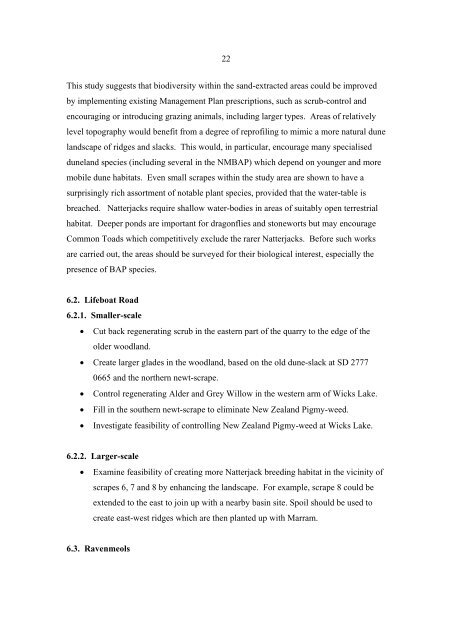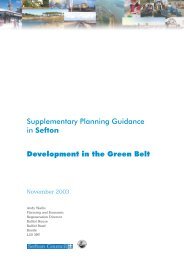The impact of sand extraction at Formby Point ... - Sefton Council
The impact of sand extraction at Formby Point ... - Sefton Council
The impact of sand extraction at Formby Point ... - Sefton Council
You also want an ePaper? Increase the reach of your titles
YUMPU automatically turns print PDFs into web optimized ePapers that Google loves.
22<br />
This study suggests th<strong>at</strong> biodiversity within the <strong>sand</strong>-extracted areas could be improved<br />
by implementing existing Management Plan prescriptions, such as scrub-control and<br />
encouraging or introducing grazing animals, including larger types. Areas <strong>of</strong> rel<strong>at</strong>ively<br />
level topography would benefit from a degree <strong>of</strong> repr<strong>of</strong>iling to mimic a more n<strong>at</strong>ural dune<br />
landscape <strong>of</strong> ridges and slacks. This would, in particular, encourage many specialised<br />
duneland species (including several in the NMBAP) which depend on younger and more<br />
mobile dune habit<strong>at</strong>s. Even small scrapes within the study area are shown to have a<br />
surprisingly rich assortment <strong>of</strong> notable plant species, provided th<strong>at</strong> the w<strong>at</strong>er-table is<br />
breached. N<strong>at</strong>terjacks require shallow w<strong>at</strong>er-bodies in areas <strong>of</strong> suitably open terrestrial<br />
habit<strong>at</strong>. Deeper ponds are important for dragonflies and stoneworts but may encourage<br />
Common Toads which competitively exclude the rarer N<strong>at</strong>terjacks. Before such works<br />
are carried out, the areas should be surveyed for their biological interest, especially the<br />
presence <strong>of</strong> BAP species.<br />
6.2. Lifebo<strong>at</strong> Road<br />
6.2.1. Smaller-scale<br />
• Cut back regener<strong>at</strong>ing scrub in the eastern part <strong>of</strong> the quarry to the edge <strong>of</strong> the<br />
older woodland.<br />
• Cre<strong>at</strong>e larger glades in the woodland, based on the old dune-slack <strong>at</strong> SD 2777<br />
0665 and the northern newt-scrape.<br />
• Control regener<strong>at</strong>ing Alder and Grey Willow in the western arm <strong>of</strong> Wicks Lake.<br />
• Fill in the southern newt-scrape to elimin<strong>at</strong>e New Zealand Pigmy-weed.<br />
• Investig<strong>at</strong>e feasibility <strong>of</strong> controlling New Zealand Pigmy-weed <strong>at</strong> Wicks Lake.<br />
6.2.2. Larger-scale<br />
• Examine feasibility <strong>of</strong> cre<strong>at</strong>ing more N<strong>at</strong>terjack breeding habit<strong>at</strong> in the vicinity <strong>of</strong><br />
scrapes 6, 7 and 8 by enhancing the landscape. For example, scrape 8 could be<br />
extended to the east to join up with a nearby basin site. Spoil should be used to<br />
cre<strong>at</strong>e east-west ridges which are then planted up with Marram.<br />
6.3. Ravenmeols















